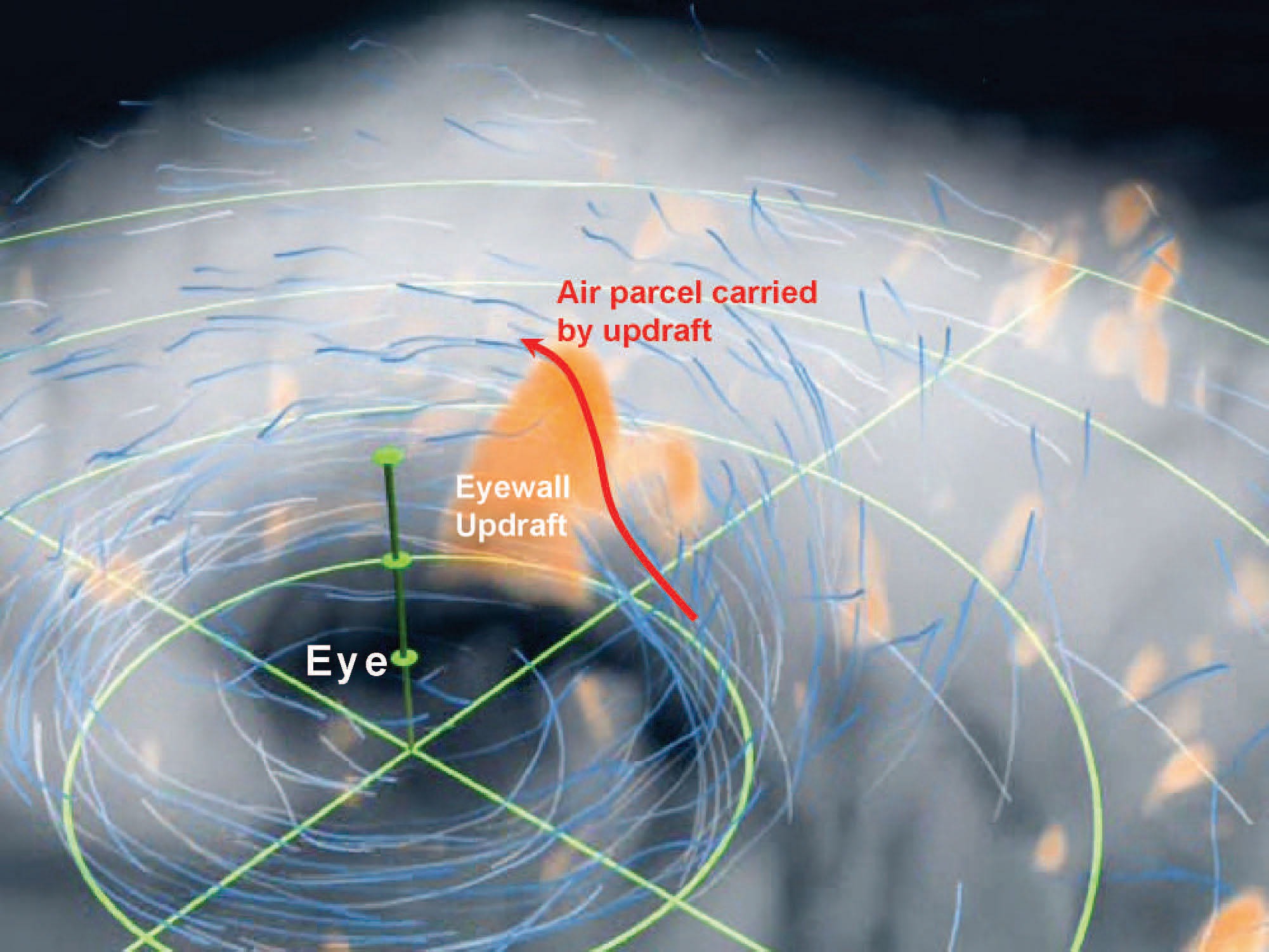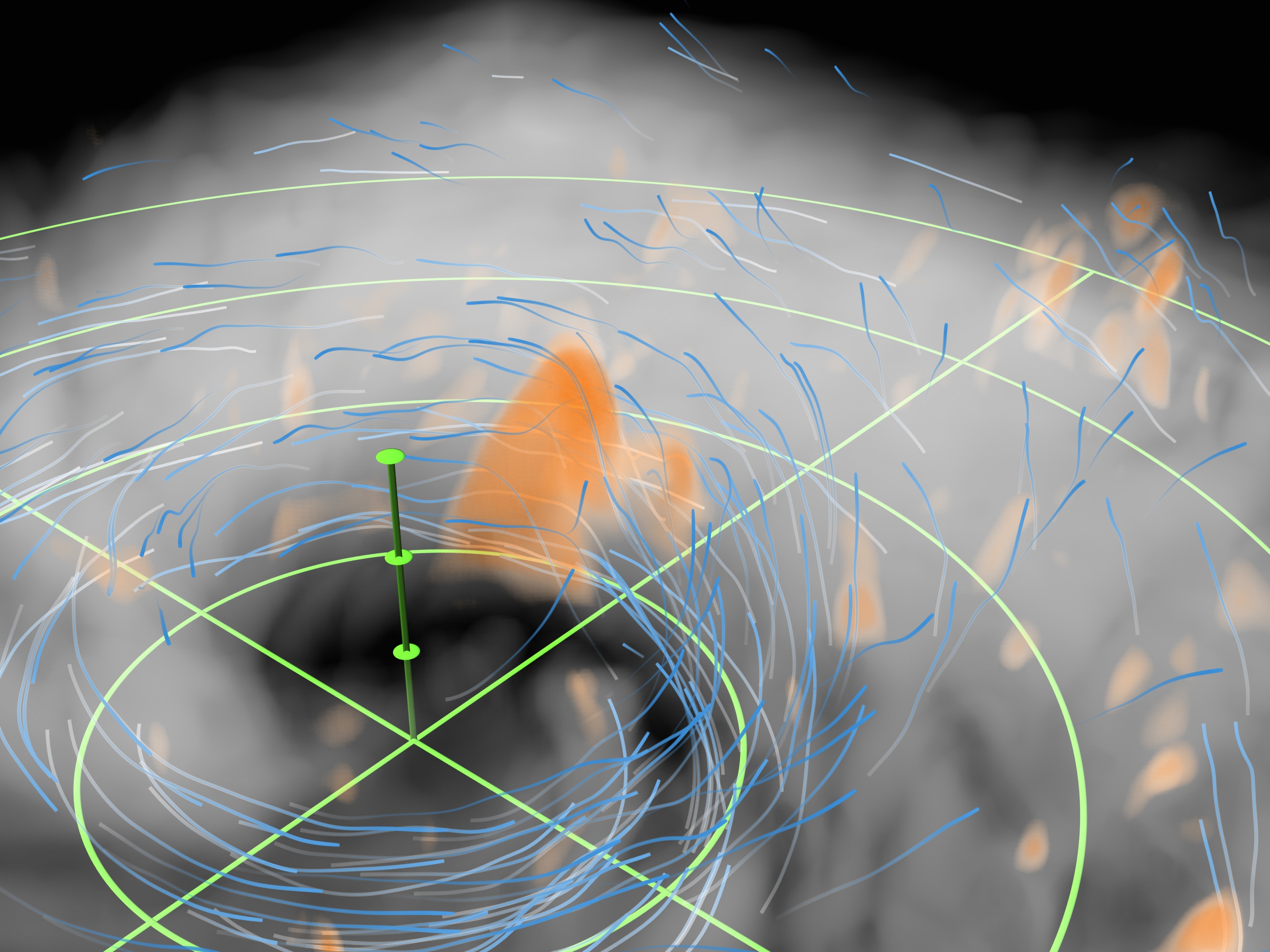Earth
ID: 3377
NASA scientists use the computer modeling field including the NCAR Mesoscale Model Version 5 (MM5) model to study the winds and updrafts near the hurricane's eye. An updraft is the vertical upward movement of air inside of a storm. This research focuses on the processes that impact the formation, intensification, movement, structure, and precipitation organization of hurricanes. An MM5 simulation of Hurricane Bonnie (1998) suggests that the timing and location of individual updrafts that produce the rainfall (often concentrated on very small-scales) are controlled by intense, small-scale regions of rapidly swirling flow in the eyewall.
The winds in hurricanes are often described in terms of radial (in toward the center or out away from it) and tangential (the swirling flow around a hurricane) winds. By looking at the urad field, one can see where the main inflow and outflow regions of the storm are, which can be important for a variety of reasons. Eyewall mesovortices are small scale rotational features found in the eyewalls of intense tropical cyclones. In these vortices, wind speed can be up to 10% higher than in the rest of the eyewall. Eyewall mesovortices are a significant factor in the formation of tornadoes after tropical cyclone landfall. Mesovortices can spawn rotation in individual thunderstorms (a mesocyclone), which leads to tornadic activity. At landfall, friction is generated between the circulation of the tropical cyclone and land. This can allow the mesovortices to descend to the surface, causing large outbreaks of tornadoes.


A Hurricane Model
The winds in hurricanes are often described in terms of radial (in toward the center or out away from it) and tangential (the swirling flow around a hurricane) winds. By looking at the urad field, one can see where the main inflow and outflow regions of the storm are, which can be important for a variety of reasons. Eyewall mesovortices are small scale rotational features found in the eyewalls of intense tropical cyclones. In these vortices, wind speed can be up to 10% higher than in the rest of the eyewall. Eyewall mesovortices are a significant factor in the formation of tornadoes after tropical cyclone landfall. Mesovortices can spawn rotation in individual thunderstorms (a mesocyclone), which leads to tornadic activity. At landfall, friction is generated between the circulation of the tropical cyclone and land. This can allow the mesovortices to descend to the surface, causing large outbreaks of tornadoes.


Related Documentation
Visualization Credits
Lori Perkins (NASA/GSFC): Lead Animator
Greg Shirah (NASA/GSFC): Animator
Alex Kekesi (Global Science and Technology, Inc.): Animator
James W. Williams (GST): Animator
Scott Braun (NASA/GSFC): Scientist
Owen Kelley (George Mason University): Scientist
Greg Shirah (NASA/GSFC): Animator
Alex Kekesi (Global Science and Technology, Inc.): Animator
James W. Williams (GST): Animator
Scott Braun (NASA/GSFC): Scientist
Owen Kelley (George Mason University): Scientist
Please give credit for this item to:
NASA/Goddard Space Flight Center Scientific Visualization Studio
NASA/Goddard Space Flight Center Scientific Visualization Studio
Short URL to share this page:
https://svs.gsfc.nasa.gov/3377
Data Used:
Note: While we identify the data sets used in these visualizations, we do not store any further details nor the data sets themselves on our site.
Keywords:
DLESE >> Natural hazards
GCMD >> Earth Science >> Atmosphere >> Atmospheric Phenomena >> Hurricanes
SVS >> Model Data
NASA Science >> Earth
GCMD keywords can be found on the Internet with the following citation: Olsen, L.M., G. Major, K. Shein, J. Scialdone, S. Ritz, T. Stevens, M. Morahan, A. Aleman, R. Vogel, S. Leicester, H. Weir, M. Meaux, S. Grebas, C.Solomon, M. Holland, T. Northcutt, R. A. Restrepo, R. Bilodeau, 2013. NASA/Global Change Master Directory (GCMD) Earth Science Keywords. Version 8.0.0.0.0
https://svs.gsfc.nasa.gov/3377
Data Used:
Mesoscale Model Version 5 (MM5)/MM5
Model - PSU/NCAR - 08/22/1998 15Z-21Z
Model dataset from Penn State and The National Center for Atmospheric Research
Keywords:
DLESE >> Natural hazards
GCMD >> Earth Science >> Atmosphere >> Atmospheric Phenomena >> Hurricanes
SVS >> Model Data
NASA Science >> Earth
GCMD keywords can be found on the Internet with the following citation: Olsen, L.M., G. Major, K. Shein, J. Scialdone, S. Ritz, T. Stevens, M. Morahan, A. Aleman, R. Vogel, S. Leicester, H. Weir, M. Meaux, S. Grebas, C.Solomon, M. Holland, T. Northcutt, R. A. Restrepo, R. Bilodeau, 2013. NASA/Global Change Master Directory (GCMD) Earth Science Keywords. Version 8.0.0.0.0











